🔬 History of Science: Essential Concepts for Reading Comprehension
The history of science traces humanity’s journey to understand the natural world, charting major discoveries, theories, and technological advancements that have shaped modern civilization. From the Scientific Revolution to cutting-edge developments like CRISPR, this field explores how science evolves through experimentation, innovation, and cultural shifts. RC passages on this topic often focus on the interplay between scientific thought, societal change, and technological progress. Mastering these concepts provides a comprehensive view of science’s transformative power.
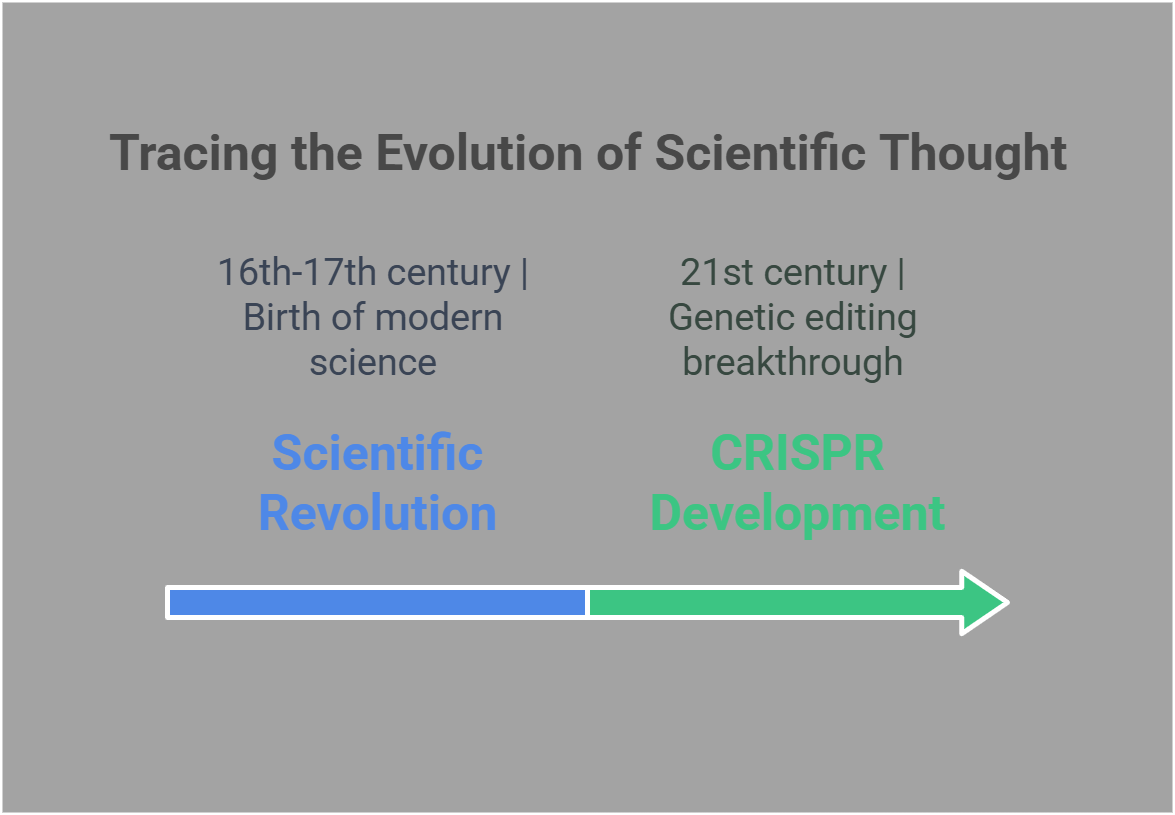
📋 Overview
This guide explores the following essential concepts in the history of science:
- Scientific Revolution
- Darwinism
- Relativity Theory
- Quantum Mechanics
- Germ Theory
- Industrial Revolution
- Enlightenment Science
- Space Exploration
- CRISPR Technology
- Vaccination History
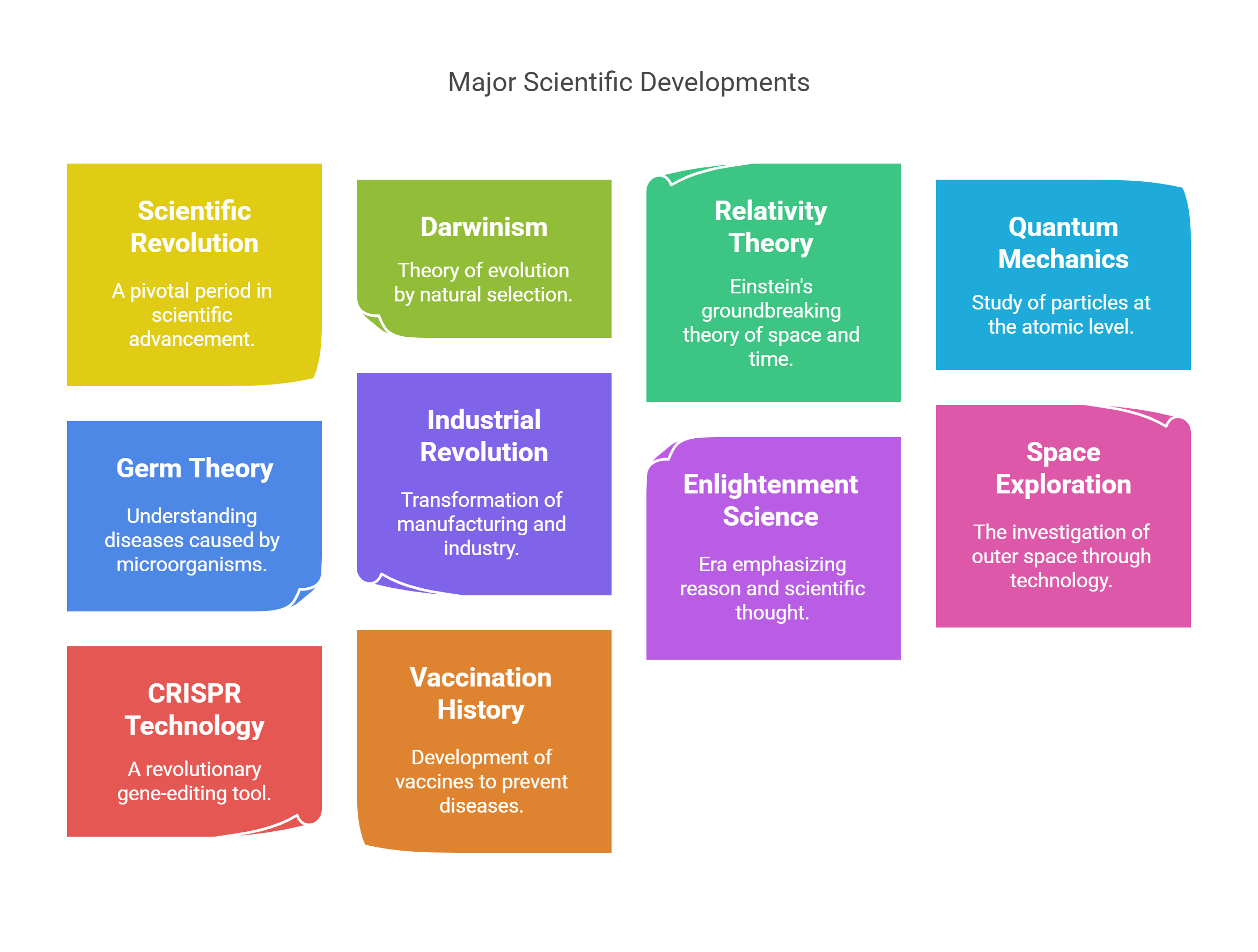
🔍 Detailed Explanations
1. Scientific Revolution
Detailed Explanation: The Scientific Revolution, spanning the 16th to 18th centuries, marked a dramatic transformation in scientific thought. It shifted knowledge acquisition from reliance on tradition and religious doctrine to observation, experimentation, and the use of the scientific method. This period challenged medieval understandings of the universe, laying the foundation for modern science.
- Key Contributions:
- Nicolaus Copernicus (1473–1543): Introduced the heliocentric theory, proposing that the Earth orbits the Sun, overturning the long-held geocentric model.
- Galileo Galilei (1564–1642): Advanced observational astronomy with his telescopic studies, providing evidence for Copernican theory. He also established principles of motion that challenged Aristotelian physics.
- Isaac Newton (1643–1727): Synthesized earlier works into a cohesive framework with his Principia Mathematica, introducing the laws of motion and universal gravitation.
- Impact:
- Established empirical evidence as the cornerstone of scientific inquiry.
- Encouraged the development of disciplines such as physics, astronomy, and biology.
Explained Simply: The Scientific Revolution is like switching from guessing to experimenting—using evidence to explain how the universe works.
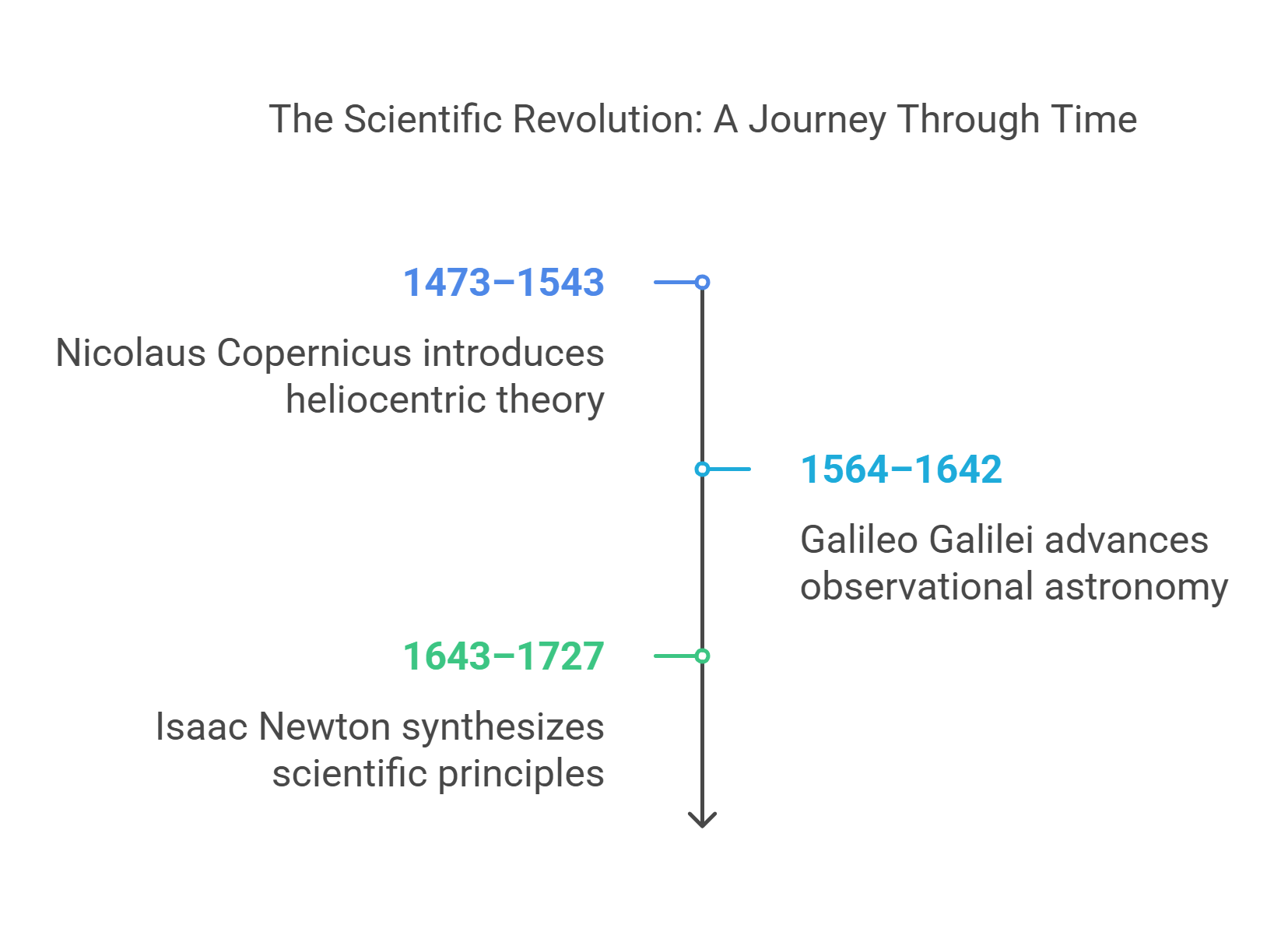
2. Darwinism
Detailed Explanation: Darwinism refers to the theory of evolution by natural selection, as articulated by Charles Darwin in On the Origin of Species (1859). This groundbreaking theory offered a scientific explanation for the diversity of life, emphasizing adaptation and the survival of the fittest.
- Core Principles:
- Variation: Within populations, individuals differ in traits such as size, color, or behavior.
- Natural Selection: Traits that enhance survival and reproduction become more common over generations.
- Common Descent: All species share common ancestors, forming a tree of life.
- Scientific Context: Darwin built on earlier ideas, such as Lamarck’s theory of inheritance of acquired characteristics, but replaced it with evidence-based explanations like fossil records, geographic distribution, and embryology.
- Impact:
- Provided a unifying framework for biology.
- Sparked debates on creationism versus evolution that continue today.
Explained Simply: Darwinism is like nature’s editing tool—favorable traits are kept, while less useful ones fade away over time.
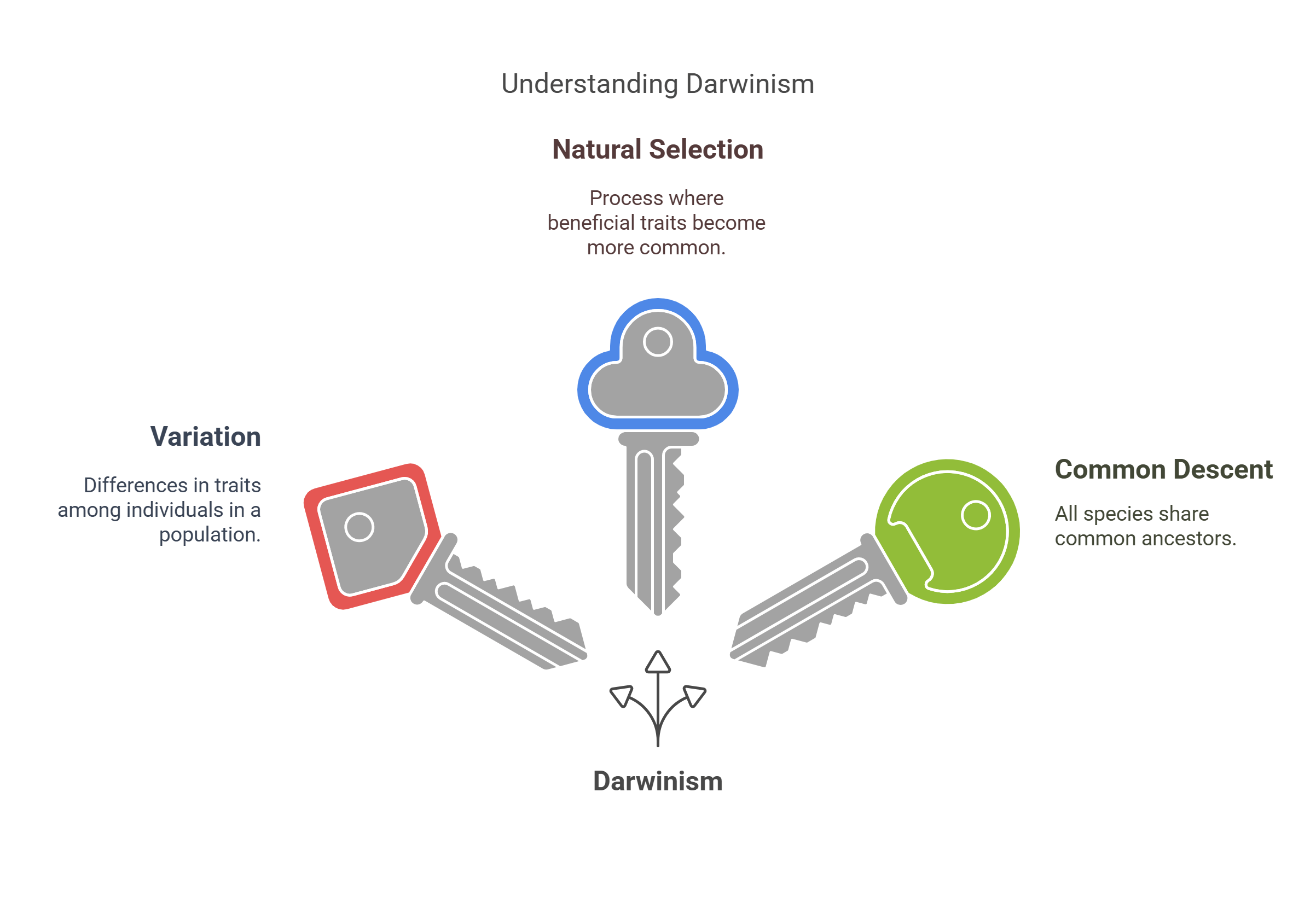
3. Relativity Theory
Detailed Explanation: Albert Einstein’s theory of relativity, developed in the early 20th century, revolutionized physics by addressing the nature of space, time, and gravity. It consists of two parts:
- Special Relativity (1905):
- Demonstrated that time and space are relative to the observer’s motion.
- Introduced the famous equation E=mc2, linking energy and mass.
- General Relativity (1915):
- Described gravity as the curvature of spacetime caused by massive objects.
- Predicted phenomena like gravitational waves and black holes.
- Key Experimental Confirmations:
- Arthur Eddington’s 1919 observation of starlight bending around the Sun during a solar eclipse confirmed general relativity’s predictions.
- Impact:
- Transformed understanding of the cosmos, influencing fields like astrophysics and cosmology.
- Enabled modern technologies such as GPS, which relies on relativistic time adjustments.
Explained Simply: Relativity shows that time and space are stretchy—they change depending on how fast you move or how massive an object is.
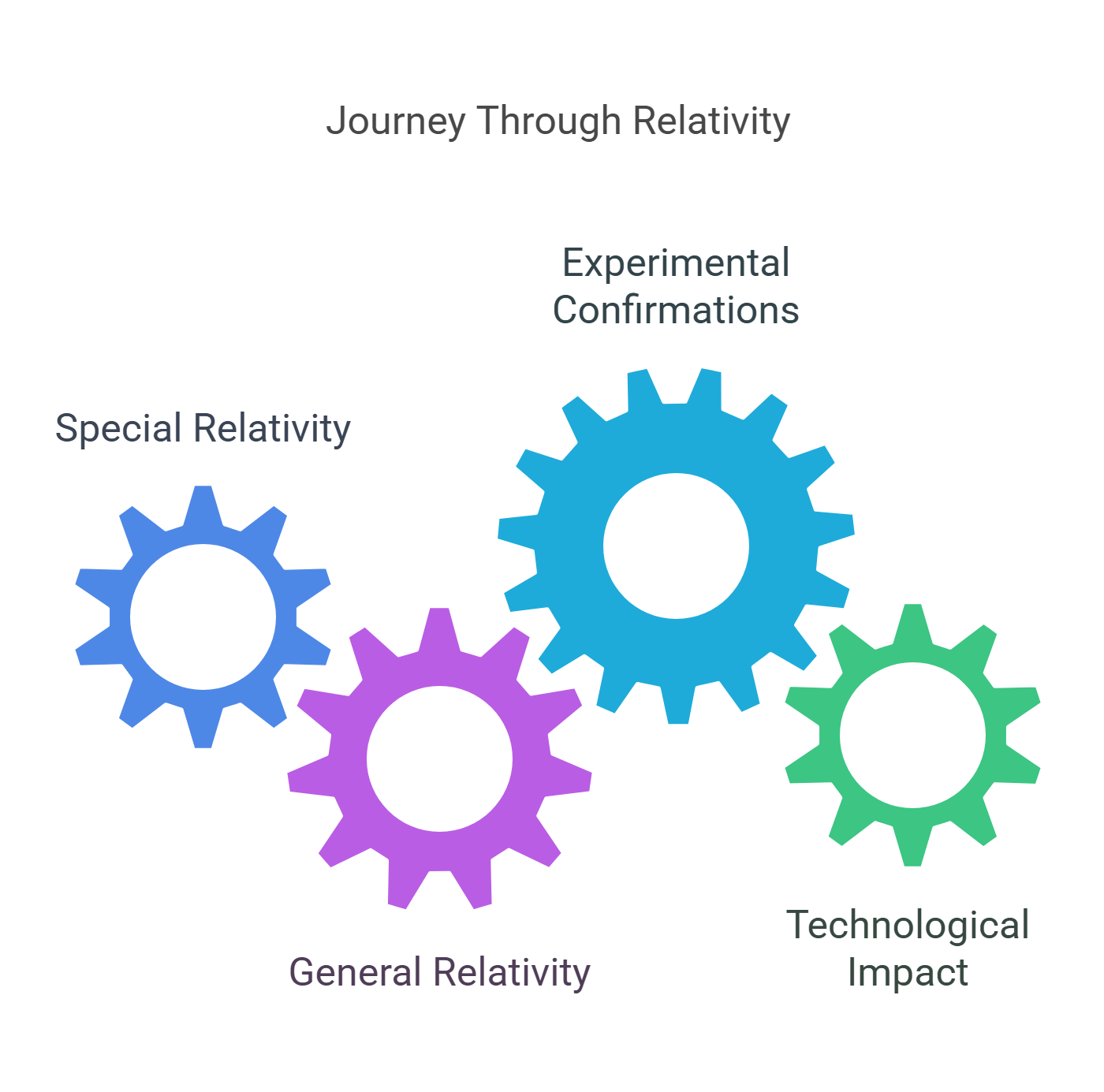
4. Quantum Mechanics
Detailed Explanation: Quantum mechanics, developed in the early 20th century, examines the behavior of matter and energy at the smallest scales—atoms and subatomic particles. It challenges classical physics with its counterintuitive principles.
- Core Concepts:
- Wave-Particle Duality: Particles like electrons and photons can behave as both waves and particles.
- Uncertainty Principle: Heisenberg’s principle states that we cannot precisely measure both the position and momentum of a particle simultaneously.
- Superposition: Particles can exist in multiple states at once until observed.
- Key Figures:
- Max Planck: Introduced the quantum concept, proposing that energy is quantized in discrete packets (quanta).
- Niels Bohr: Developed the Bohr model of the atom, explaining electron orbits.
- Erwin Schrödinger: Formulated the Schrödinger equation to describe quantum systems.
- Impact:
- Forms the foundation of modern technologies like semiconductors, lasers, and quantum computing.
- Challenges philosophical views on determinism and reality.
Explained Simply: Quantum mechanics is like a mysterious dance at the atomic level, where particles follow strange, unpredictable rules.
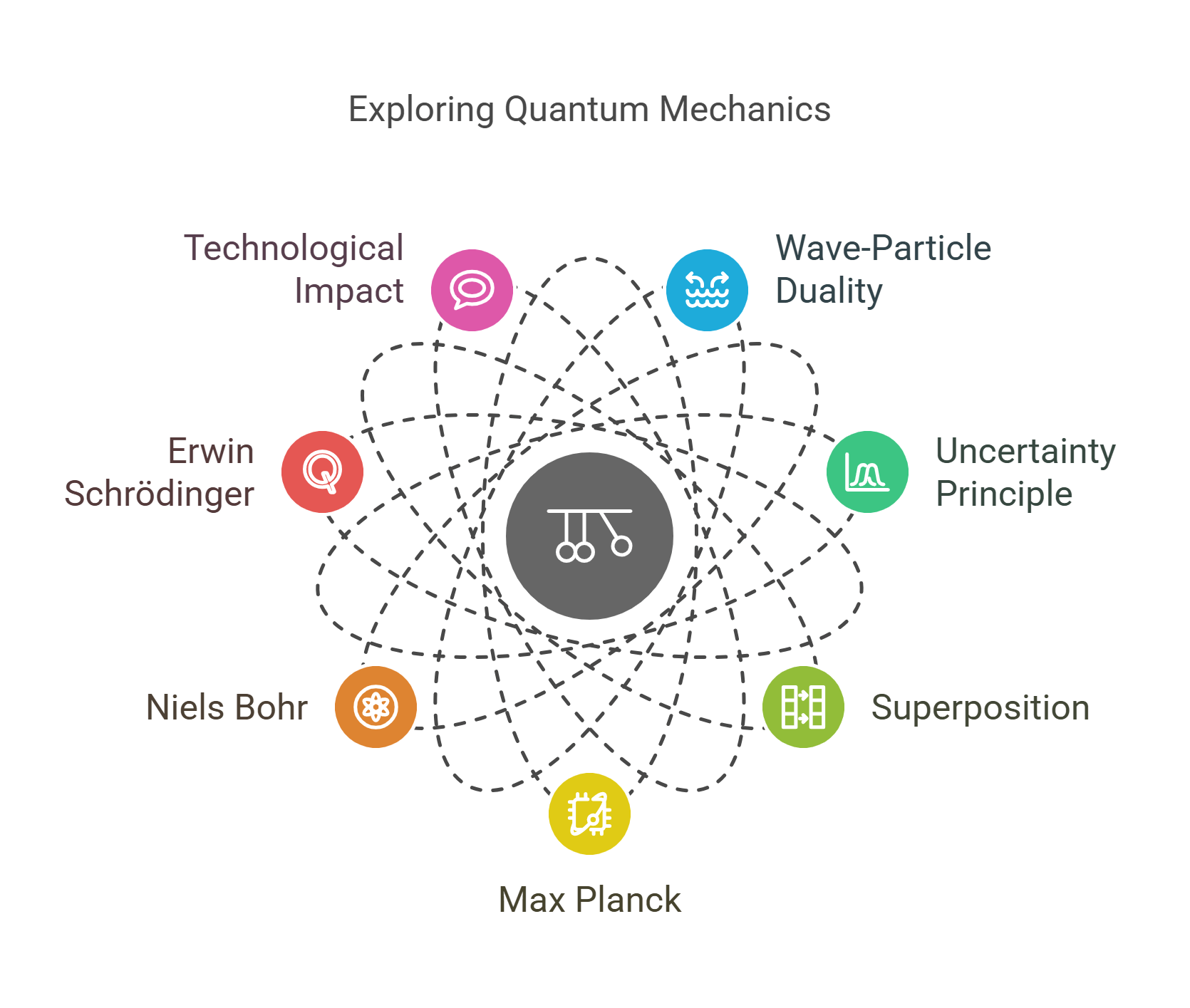
5. Germ Theory
Detailed Explanation: Germ theory, developed in the 19th century, revolutionized medicine by identifying microorganisms as the cause of many diseases. Before this, illnesses were often attributed to “miasmas” (bad air) or imbalances in bodily humors.
- Key Contributors:
- Louis Pasteur: Demonstrated that microbes cause fermentation and spoilage, leading to techniques like pasteurization.
- Robert Koch: Proved specific microbes cause specific diseases (e.g., tuberculosis). His postulates established criteria for linking pathogens to illnesses.
- Scientific Advancements:
- Development of sterilization methods for surgical instruments.
- Creation of vaccines to prevent microbial infections.
- Impact:
- Reduced mortality rates through better hygiene, antibiotics, and vaccines.
- Laid the foundation for modern microbiology and epidemiology.
Explained Simply: Germ theory uncovered the tiny, invisible culprits behind diseases, paving the way for modern medicine.
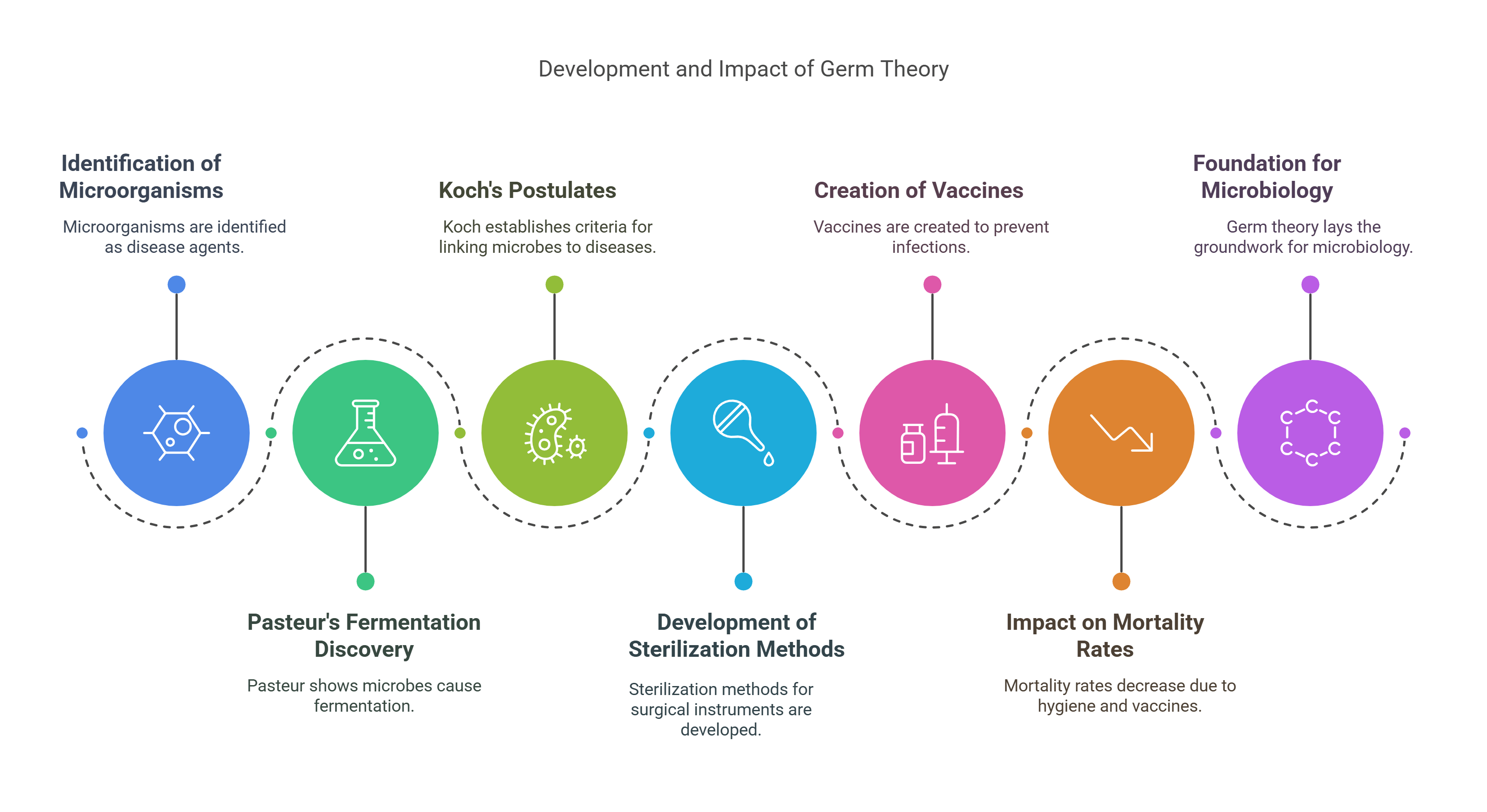
6. Industrial Revolution
Detailed Explanation: The Industrial Revolution (late 18th to early 19th centuries) was a period of rapid technological, economic, and social transformation. It marked the transition from agrarian economies to industrialized, urban-centered societies driven by mechanized production.
- Key Scientific Contributions:
- Integration of physics and engineering in developing steam engines, leading to advancements in transportation and manufacturing.
- Innovations in metallurgy and chemical processes for producing steel and textiles.
- Major Inventions:
- Steam Engine (James Watt): Revolutionized energy use and powered factories, trains, and ships.
- Spinning Jenny (James Hargreaves): Increased textile production efficiency.
- Impact:
- Accelerated urbanization and economic growth.
- Paved the way for modern industrial engineering and transportation.
- Brought about environmental changes and social challenges, such as labor exploitation and pollution.
Explained Simply: The Industrial Revolution is like shifting gears from manual to automatic, revolutionizing how the world works and produces.
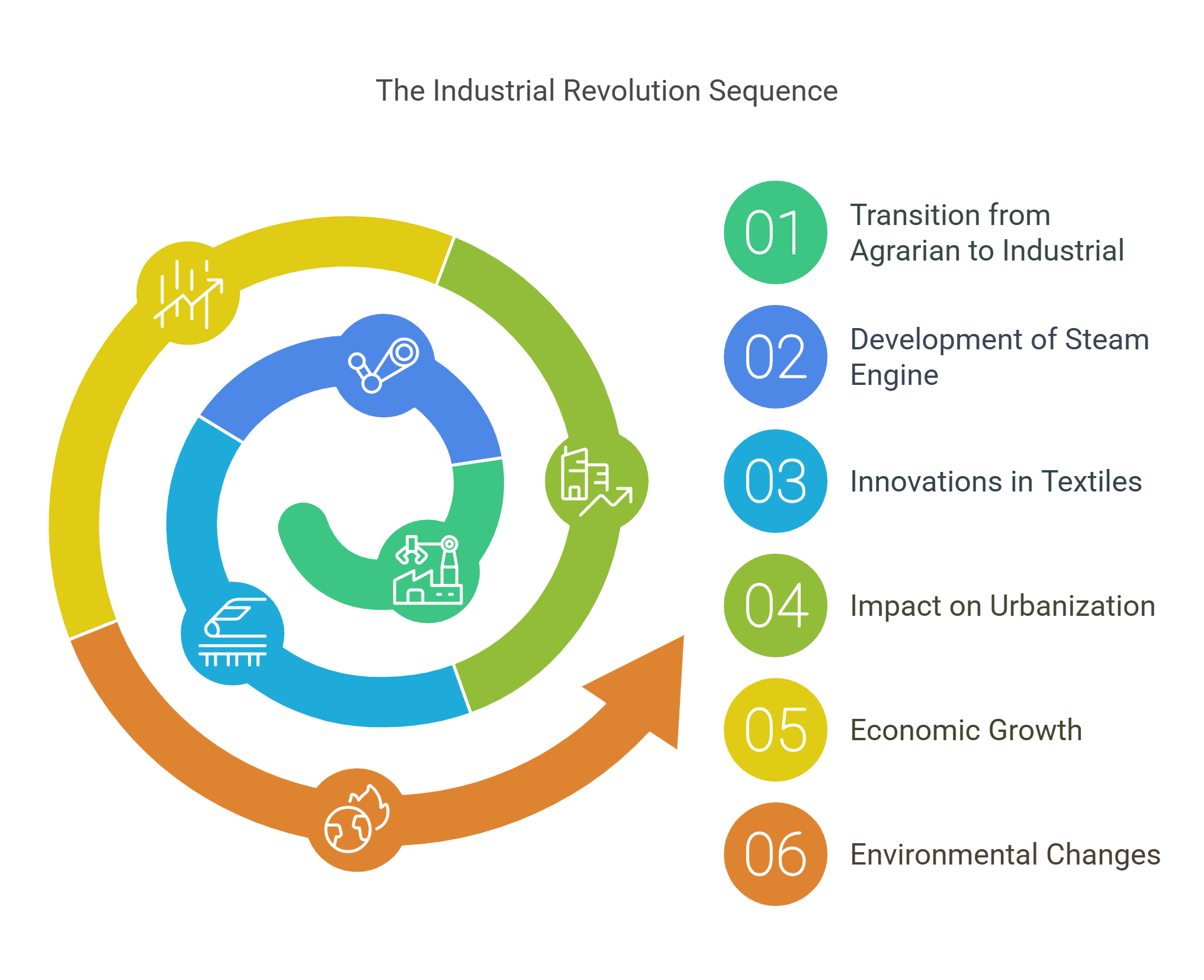
7. Enlightenment Science
Detailed Explanation: The Enlightenment (17th–18th centuries), also known as the “Age of Reason,” emphasized rationality, empirical evidence, and scientific progress. It fostered a culture of inquiry that connected science with human advancement and societal reform.
- Key Philosophical Shifts:
- Rejection of superstition and reliance on empirical observation.
- Belief in the power of human reason to improve society.
- Major Figures:
- Francis Bacon: Advocated for inductive reasoning and systematic experimentation (scientific method).
- René Descartes: Pioneered deductive reasoning, famously stating, “I think, therefore I am.”
- Carolus Linnaeus: Developed the first systematic classification of plants and animals (taxonomy).
- Impact:
- Promoted the democratization of knowledge through encyclopedias and public education.
- Led to advancements in fields like biology, physics, and astronomy.
Explained Simply: Enlightenment science is like turning curiosity into structured problem-solving, improving life with reason and evidence.
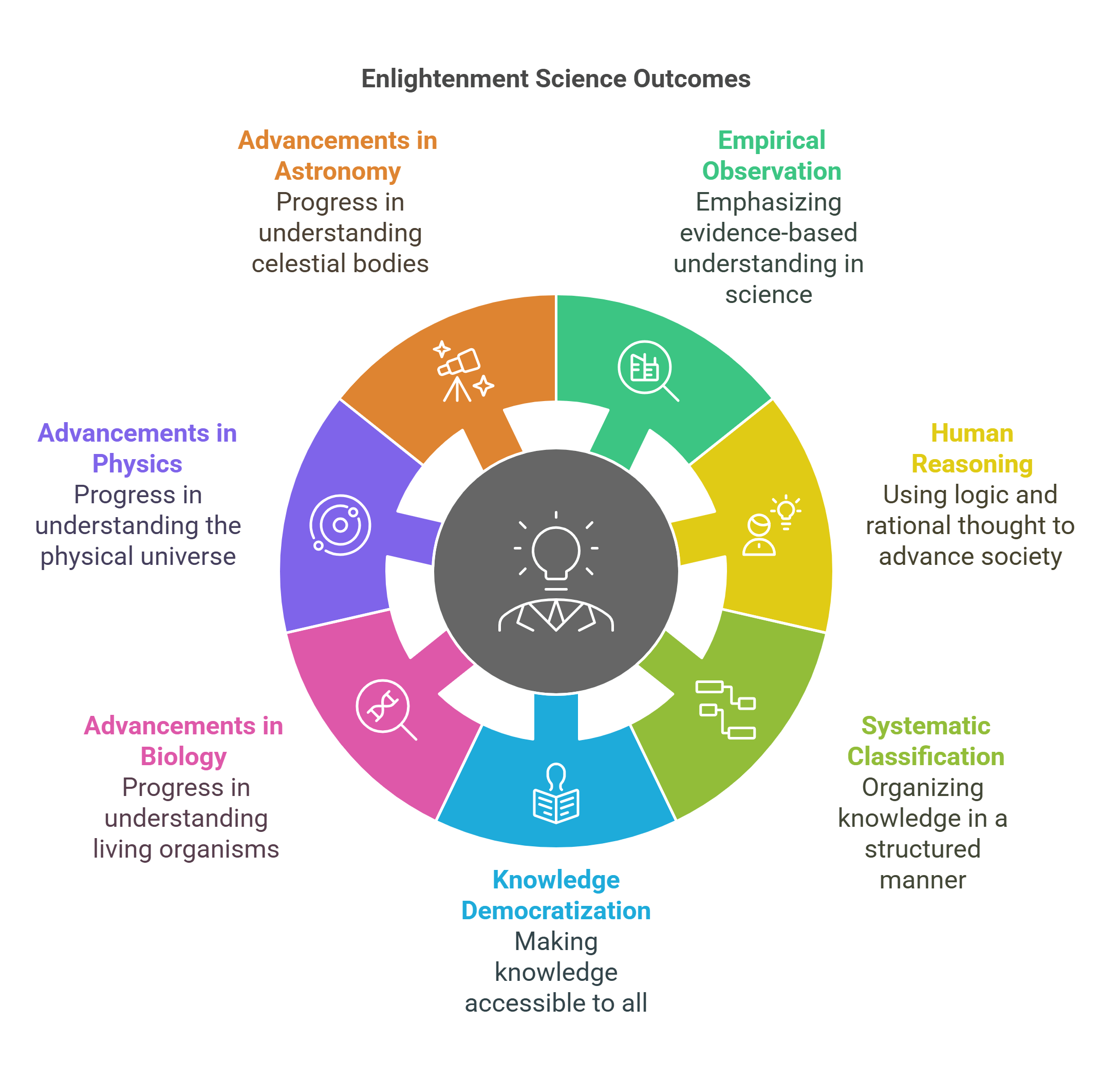
8. Space Exploration
Detailed Explanation: Space exploration, driven by advancements in rocketry, astronomy, and engineering, represents humanity’s quest to study the cosmos. It has expanded our understanding of the universe and pushed technological boundaries.
- Milestones:
- 1957: Launch of Sputnik, the first artificial satellite (USSR).
- 1961: Yuri Gagarin became the first human in space (USSR).
- 1969: Apollo 11 mission landed Neil Armstrong and Buzz Aldrin on the Moon (USA).
- Modern Era: Mars exploration, with the Perseverance rover searching for signs of ancient life.
- Technological Contributions:
- Development of satellite communication systems.
- Creation of reusable rockets (e.g., SpaceX).
- Impact:
- Enhanced understanding of planetary systems and Earth’s place in the universe.
- Enabled global navigation and communication systems.
Explained Simply: Space exploration is humanity’s leap into the unknown, discovering the secrets of the stars while innovating for life on Earth.
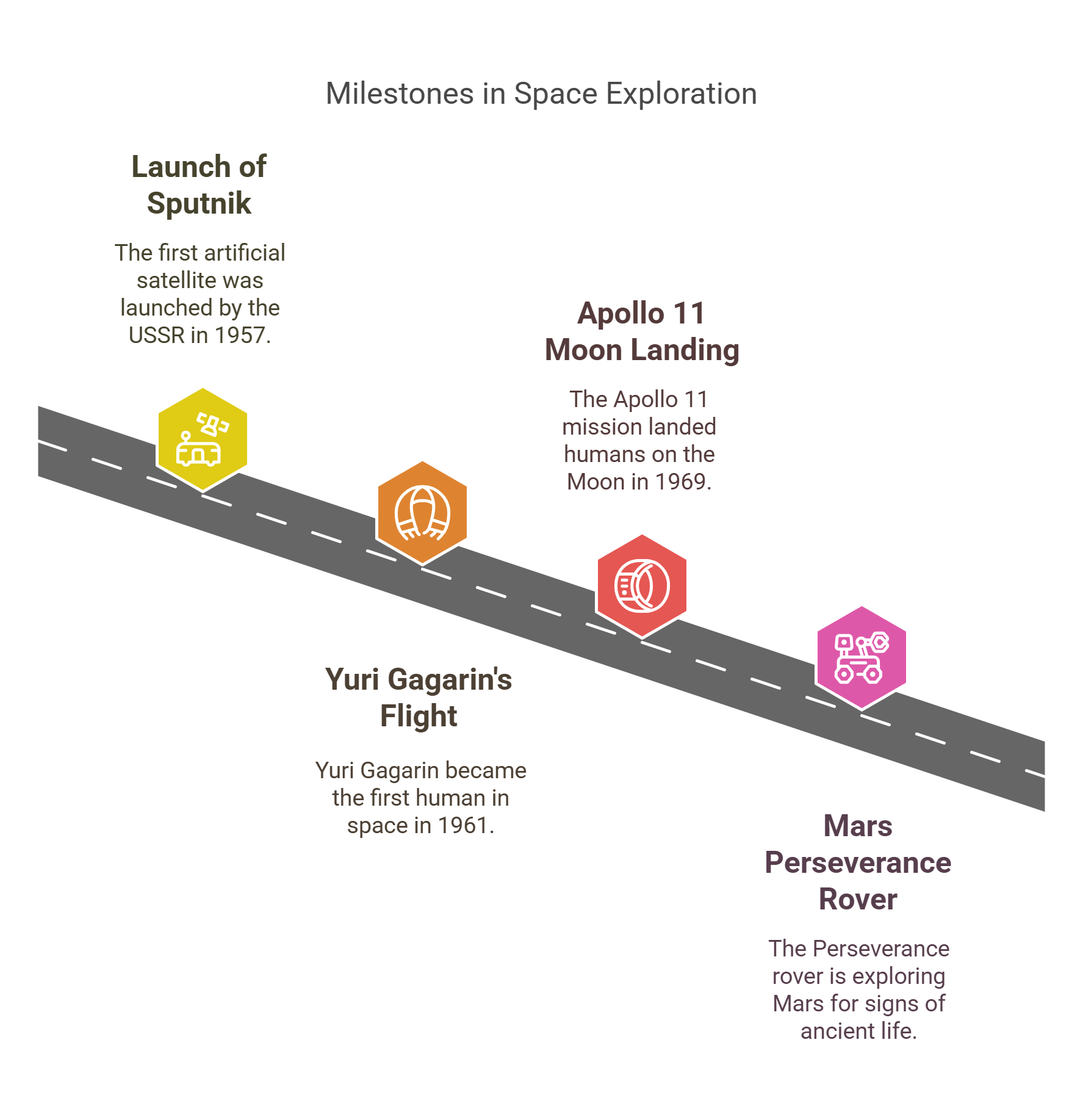
9. CRISPR Technology
Detailed Explanation: CRISPR-Cas9 (Clustered Regularly Interspaced Short Palindromic Repeats) is a revolutionary gene-editing technology that allows scientists to modify DNA with unprecedented precision.
- How It Works:
- The system uses a guide RNA to locate specific DNA sequences.
- The Cas9 enzyme cuts the DNA at the targeted location, enabling scientists to delete, repair, or insert new genetic material.
- Applications:
- Medicine: Treating genetic disorders such as sickle cell anemia and cystic fibrosis.
- Agriculture: Developing disease-resistant and high-yield crops.
- Research: Advancing understanding of genetic functions and disease mechanisms.
- Ethical Considerations: Concerns about “designer babies” and unintended ecological consequences.
Explained Simply: CRISPR is like a molecular scalpel, letting scientists rewrite the genetic code of life with precision.
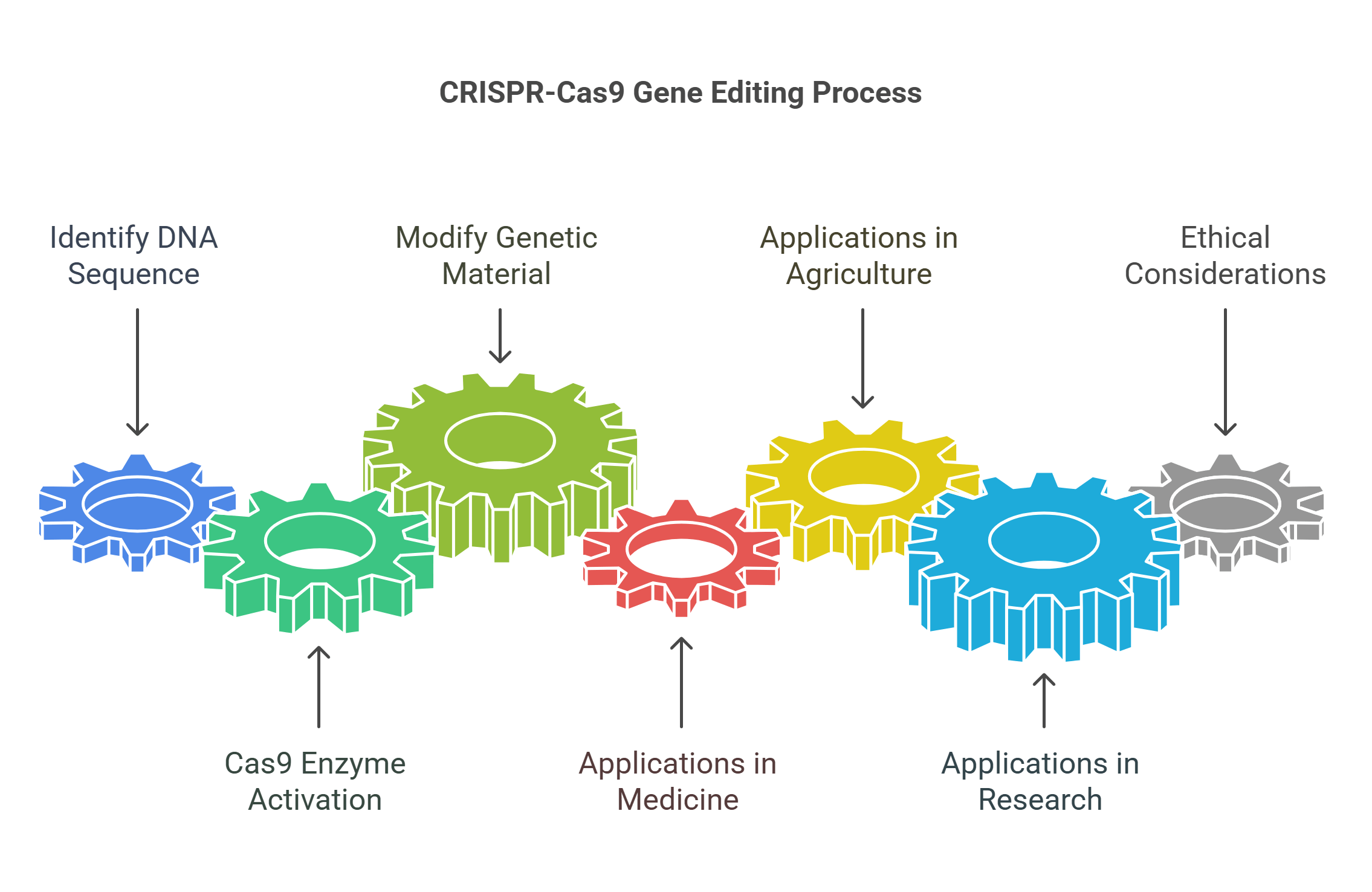
10. Vaccination History
Detailed Explanation: Vaccination is one of the most transformative medical breakthroughs, preventing millions of deaths by preparing the immune system to fight diseases.
- Historical Milestones:
- 1796: Edward Jenner developed the first smallpox vaccine using cowpox, laying the groundwork for immunology.
- 20th Century: Widespread vaccination campaigns eradicated smallpox and significantly reduced diseases like polio and measles.
- 21st Century: mRNA vaccines (e.g., Pfizer-BioNTech, Moderna) were developed to combat COVID-19, representing a leap in vaccine technology.
- How Vaccines Work:
- Introduce weakened or inactivated pathogens or genetic material to stimulate the immune response.
- The immune system produces antibodies, creating long-term protection against future infections.
- Impact:
- Dramatically reduced mortality and morbidity from infectious diseases.
- Enabled global public health initiatives, such as the eradication of smallpox.
Explained Simply: Vaccination is like a training program for your immune system, teaching it to fight off harmful invaders before they cause illness.
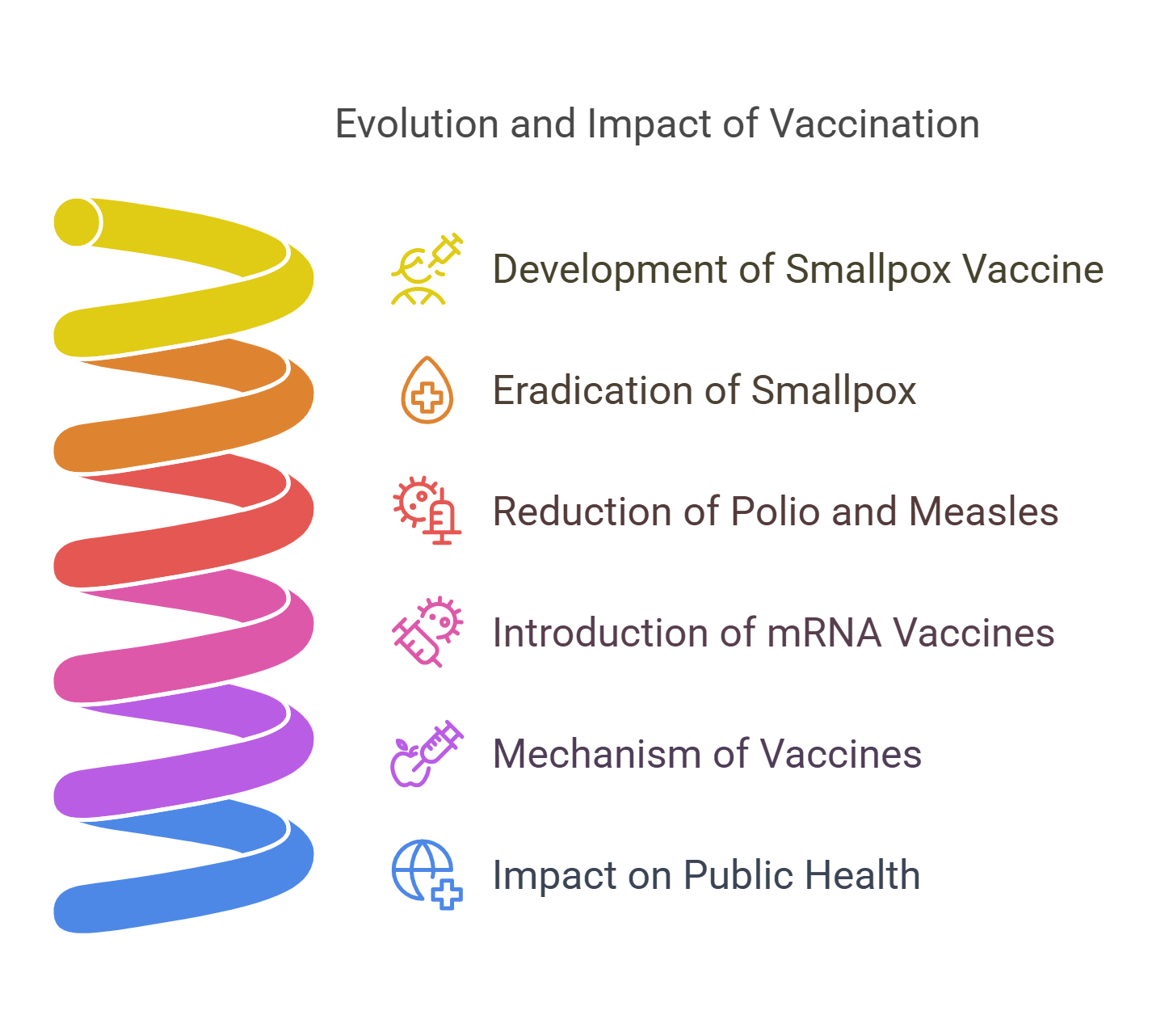
✨ Conclusion
The history of science reveals humanity’s journey to understand and innovate, from the transformative effects of the Industrial Revolution to the precise genetic editing of CRISPR. By exploring these concepts, readers gain a deeper appreciation of how scientific discovery has shaped our world and continues to push the boundaries of possibility.










